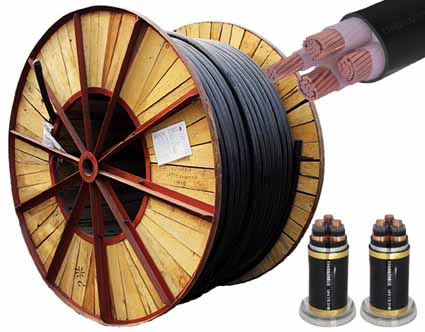Manufacturer of XLPE (PE) insulated cables

XLPE (PE) insulated cable is a kind of cable suitable for power distribution networks and other fields, and has the advantages of PVC insulated cables. It has simple structure, light weight, good heat resistance, strong load capacity, non-melting, chemical corrosion resistance, and high mechanical strength.
XLPE cable characteristics
The cross-linked polyethylene insulated cable uses chemical or physical methods to transform the polyethylene molecule of the cable insulation from a linear molecular structure to a main network molecular structure. That is, the thermoplastic polyethylene is transformed into thermosetting cross-linked polyethylene, thereby greatly improving its heat resistance and mechanical properties, reducing its shrinkage, making it no longer melted after being heated, and maintaining excellent electrical properties.
Characteristics of XLPE cable
Cross-linked polyethylene insulated cables use peroxide cross-linking methods to change polyethylene molecules from linear molecular structures to three-dimensional network structures, and from thermoplastic materials to thermosetting materials. The working temperature is increased from 70°C to 90°C, which significantly improves the current-carrying capacity of the cable. XLPE insulated cables have the following advantages:
1. Heat resistance: The XLPE with a net-like three-dimensional structure has excellent heat resistance. It will not decompose and carbonize below 300℃, the long-term working temperature can reach 90℃, and the thermal life can reach 40 years.
2. Insulation performance: XLPE maintains the original good insulation properties of PE, and the insulation resistance is further increased. The dielectric loss tangent value is very small, and it is not greatly affected by temperature.
3. Mechanical characteristics: Due to the establishment of new chemical bonds between macromolecules, the hardness, stiffness, wear resistance and impact resistance of XLPE have been improved, thereby making up for the shortcomings of PE being vulnerable to environmental stress and cracking.
4. Chemical resistance:
XLPE has strong acid and alkali resistance and oil resistance. Its combustion products are mainly water and carbon dioxide, which are less harmful to the environment and meet the requirements of modern fire safety.
Application of XLPE cable
Cross-linked polyethylene insulated cables are suitable for power distribution networks, industrial installations or other fields that require large-capacity electricity. It is used for fixed laying on power transmission and distribution lines with AC 50Hz and rated voltage 6kV~35kV. The main function is to transport electrical energy.
Key technical issues of cross-linked polyethylene cables
Although cross-linked polyethylene (XLPE) has many outstanding advantages as an insulating material, and some excellent products have been developed after years of hard work, there are still some important problems that need to be solved. From the perspective of the HVDC cable market, traditional HVDC cables such as impregnated paper-insulated cables or oil-filled cables are still mainstream products, and improvements are still being made on this basis. This can be seen in the products produced by the world's two largest cable companies, Prismmann in Italy and Nexans in France. In terms of the products of 500kV and above HVDC transmission cables, oil-filled-paper insulated cables are still the absolute mainstream products. In contrast, 500kV HVDC XLPE insulated cables are only in the test certification stage in Japan without commercial certification. Although ABB’s light-duty high-voltage DC transmission cables have passed commercial certification for 80kV, 150kV and 320kV, they are only applied to engineering projects with two voltage levels of 80kV and 150kV. From this, it can be seen that increasing the voltage level and capacity is the development direction of high-voltage DC XLPE insulated cable products, which also puts forward corresponding technical requirements.
From a technical point of view, the space charge generated and accumulated during the HVDC transmission process of XLPE insulated cables is the most important problem that polymer insulating materials need to face. It has always limited the application of polymer insulation materials in HVDC cables. Therefore, the mechanism of space charge accumulation and suppression of space charge accumulation are both the focus of research. Including the properties of the semiconductor-insulator interface and the semiconductor material-insulator material in the corresponding polymer insulation cables, the research on the properties of the insulator interface, the effect of temperature gradients on space charge, and the process of space charge accumulation.
Of course, it also includes some other problems: the mechanism of insulation material aging, the long-term stability of new materials, and the influence of partial discharge. It is not clear whether the upper limit of the operating voltage should be determined by the measurement of space charge or by the threshold voltage of electrical aging.





